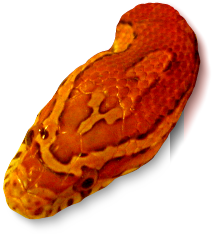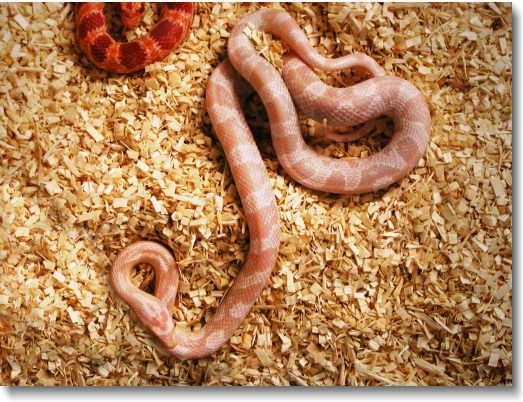Corn Snake
pictures and facts

Food and Water
In captivity corn snakes are fed mice that are purchased frozen, and warmed up to body temperature before feeding. Hatchling corn snakes begin with Pinky mice, and progress up to large Adult mice. [62] You may feed a corn snake twice a week, depending on the prey's size, but once a week is usually enough. [63] Note: you may hear some people recommend feeding live prey to your snake. However this can be very unsafe for your snake. Snakes not interested in feeding, that are left alone with prey animals, may actually become the prey. They can also be injured during the feeding process. Finally, from the viewpoint of the prey, it is considered more humane to euthanize the prey animal before feeding. [64] One common myth about feeding live prey, is that reptiles and amphibians will only eat live prey. This is quite simply not true. Most reptiles and amphibians found in the pet trade can be easily converted to feeding on killed prey. [65]
The full view of a snow corn snake, with an amelanistic corn snake looking on.
Image Source: Photo taken by Corn Snake Pictures & Facts at the San Bernardino County Museum, with permission.
Available in two sizes:
1024 x 768 || 800 x 600
To convert a snake over to feeding on killed prey, first try dangling the
prey in front of the snake with kitchen tongs. Never hold the prey in
your fingers! Move it back and forth a bit to catch the snake's
attention, and be prepared for the strike so you can quickly release
it. [66]
Pinky mice
size: 2 grams
Fuzzy mice
size: 5 grams
Hopper mice
size: 8 grams
Small adult mice
size: 13 - 24 grams
Medium adult mice
size: 25 - 40 grams
Large adult mice
size: 40+ grams (retired breeders)
[67]
As in the wild you should feed your snake mice that are close to the same diameter as it is. If the meal is too large to swallow the snake will usually regurgitate it. Snakes also regurgitate food if they are handled too soon after feeding, or if they do not have a warm area to rest, as heat is necessary for digestion. [68] Some people believe that you can prevent a snake from outgrowing its enclosure by not feeding it enough. While there may be some anecdotal evidence for this, it is not recommended, being both unsafe for the health of your snake and cruel. [69] Corn snakes drink often, so clean water must be easily available at all times. [70] The snake will also use it for occasional bathing. However if the snake defecates in the water dish, it must be cleaned and disinfected immediately. [71]
